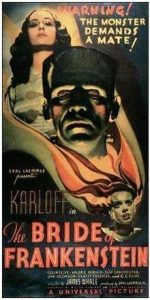Bride of Frankenstein-1935
Director James Whale
Starring Boris Karloff, Elsa Lanchester
Scott’s Review #825
Reviewed October 31, 2018
Grade: A-
After four long years as director, James Whale finally agreed to follow up on and resurrect his character, The Monster. Fortunately, Boris Karloff also returned to the role he made famous. In this installment, he meets a mate played by the gorgeous Elsa Manchester.
Critics argue that the sequel is superior to the original, but I am not so sure of that; I slightly prefer Frankenstein. Still, the aptly titled Bride of Frankenstein (1935) is a fantastic effort and a memorable classic in and of itself.
The plot picks up where the original Frankenstein ended and includes a sub-plot from the 1818 Mary Shelley novel. Having learned his lesson about the drawbacks of creating life, Dr. Frankenstein (Colin Clive) is coerced into making a female mate for the Monster.
Much of the action follows the Monster, who is on the run from hunters as he encounters devious and kindly individuals. In clever form, Manchester plays the “Bride” and Mary Shelley, who is heralded for her masterful writing.
The main difference between Frankenstein and Bride of Frankenstein is that the Monster is more developed from a character perspective. Even more empathetic and now uttering some dialogue, the pained character contains more profound moments and a damaged quality.
Karloff reportedly despised this aspect, preferring that his character be more ambivalent, using grunts and facial expressions more than words, but to me, the development works well.
As the Monster traverses the forest looking for shelter while being pursued in a witch hunt style, a lovely sequence occurs between the Monster and a lonely blind man. Attracted by the gorgeous sounds of a violin playing “Ave Maria”, the blind hermit befriends the Monster and teaches him a few words like “friend”.
Harboring no ill will towards the Creature, the old hermit feels blessed and thanks God for sending him a friend. The tender moment is then shattered when a fire burns down the cottage.
The constant theme of loneliness and despair continues what Frankenstein did and is more in line with Shelley’s novel. The Creature is a tortured soul yearning for love and affection yet suffering from a temper. He is childlike and struggles to know the difference between right and wrong.
Like Frankenstein, the sequel contains high-quality special effects and ambiance. With a storm raging (naturally), the thunder and lightning qualities add so much to a horror film, filling it with suspense and a particular science fiction element.
When the Bride is hoisted to the sky and struck by lightning, the scene is both campy and terrifying.
How delicious a character is Manchester as The Monster’s Bride? The character is forever recognizable in pop culture with her statuesque seven-foot height (the actress used stilts), white-streaked hairdo, macabre white gown, and jerky, animal-like head movements.
Timeless in characterization, the beautiful woman possesses a macabre yet humorous quality. The moment she becomes alert, sees the monster, and shrieks is a memorable moment in film history.
Throughout cinematic history, few sequels ever live up to their predecessors, but Bride comes close.
Easily able to be watched in tandem with Frankenstein and perfect for a bit of Saturday afternoon nostalgia, Bride of Frankenstein (1935) is a wonderful trip down memory lane to a time when horror was as thrilling in simple black and white as it is with all the frills added.
Thanks to Whale’s brilliant direction, both films are legendary in their inspiration and achievements.
Oscar Nominations: Best Sound Recording

